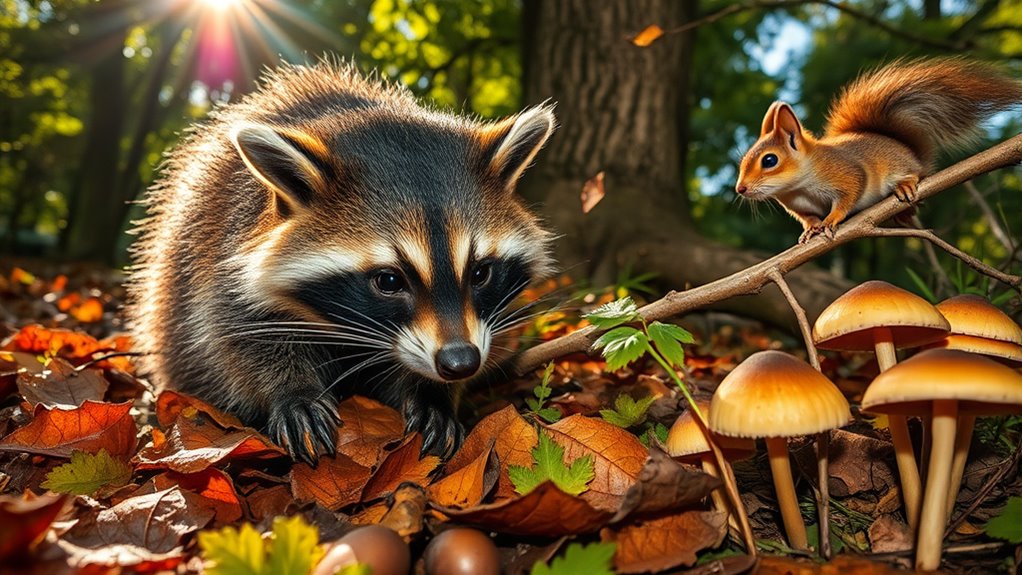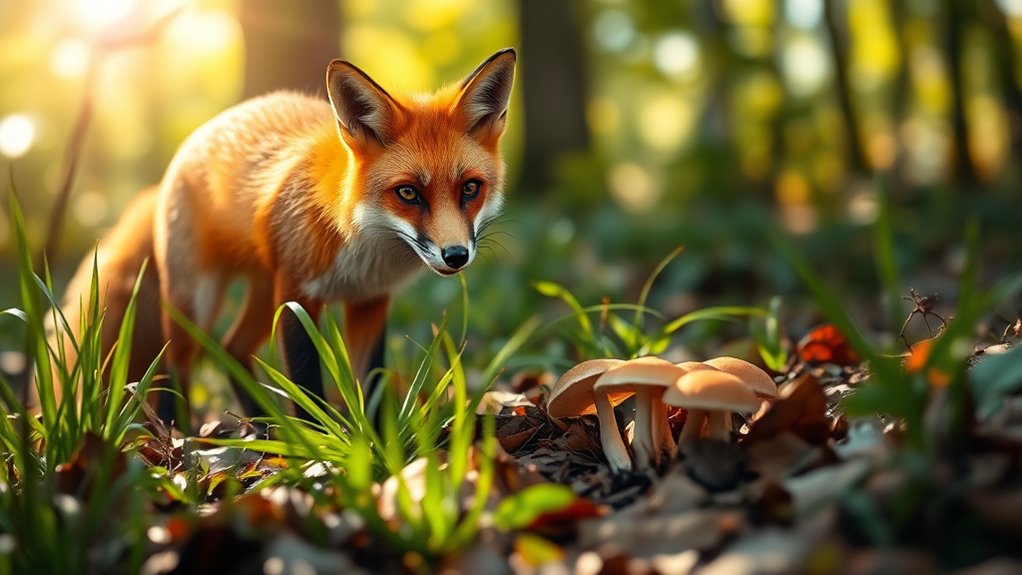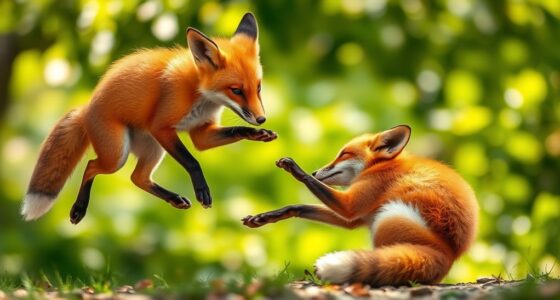Foraging strategies are key for animals to find food while staying safe from predators. Some animals forage alone, using stealth, while others work in groups to enhance food discovery and watch for threats. They often choose safe times and places to reduce risks, utilizing their social networks for increased vigilance. This balance between acquiring food and avoiding danger shapes their behavior. Curious to know how these strategies adapt over time? There’s so much more to explore!
Key Takeaways
- Animals employ various foraging techniques to locate food, enhancing their survival chances in the wild.
- Social foraging allows animals to work together, improving efficiency and covering more ground in their search for food.
- Foraging during low-activity times and in dense cover helps minimize the risk of predation while searching for food.
- Collective vigilance in groups provides safety, allowing foragers to focus on food while monitoring potential threats.
- Adaptation of foraging strategies over generations leads to improved techniques that balance food acquisition and predator avoidance.

When you think about survival in the wild, foraging strategies often come to mind as essential skills. Animals have developed a variety of techniques to locate food, and mastering these strategies can be vital for their survival. Understanding how these methods work can give you insight into the complex dynamics of nature. For instance, many animals rely on predator avoidance while foraging, ensuring they stay safe while searching for their next meal.
Foraging strategies are crucial for survival, showcasing the intricate balance between securing food and avoiding predators in nature.
As you observe different species, you’ll notice that some animals are solitary foragers, while others engage in social foraging. Social foraging allows animals to work together, enhancing their chances of finding food. For example, think about a flock of birds searching for seeds or insects. By communicating and staying close to one another, they can cover more ground and locate food sources more efficiently than if they were foraging alone. This teamwork not only increases their chances of finding food but also helps them keep an eye out for potential predators.
In the wild, predator avoidance is a significant factor that influences foraging behavior. Many animals have evolved specific strategies to minimize the risk of being caught while they search for food. For example, some species will forage in areas with dense cover, where they can quickly hide if a predator approaches. Others may forage during times when predators are less active, such as at dawn or dusk. By understanding the habits of their predators, these animals can plan their foraging activities to reduce the risk of becoming a meal themselves.
Moreover, the presence of other animals can also provide safety in numbers. When a group of animals forages together, they can watch for predators while still searching for food. This social dynamic is especially important for smaller animals that might be more vulnerable. They can benefit from the vigilance of their companions, allowing them to focus on finding food rather than constantly worrying about potential threats.
In essence, foraging strategies are a delicate balance between finding food and avoiding danger. Whether through social foraging or employing clever predator avoidance tactics, animals have honed these skills over generations. By observing these behaviors in the wild, you’ll gain a deeper appreciation for the intricate relationships that exist in nature, where every choice can mean the difference between life and death. Additionally, just as animals adapt their foraging techniques, advanced tuning software can enhance vehicle performance, illustrating the importance of customization in various contexts.
Frequently Asked Questions
How Do Environmental Changes Affect Animal Foraging Behavior?
Environmental changes can critically affect your foraging behavior. Habitat alteration disrupts familiar landscapes, making it harder for you to locate food sources. You might notice resource distribution shifting as plants and animals respond to these changes, leading you to adapt your strategies. For instance, you may have to explore new areas or alter your timing to find food. These adaptations are vital for survival as your environment continues to evolve.
What Role Do Predators Play in Foraging Strategies?
Predators play a vital role in shaping foraging strategies by influencing predator-prey dynamics. As you watch prey species adapt, you might notice their clever avoidance tactics. They change their feeding habits, often forgoing easy meals to stay safe. This tension between finding food and evading predators creates a constant game of survival. You can see how these interactions not only dictate their choices but also impact the entire ecosystem’s balance.
Can Foraging Strategies Vary by Season?
Yes, foraging strategies can definitely vary by season. You’ll notice that animals often engage in seasonal migration to find food sources that are abundant at different times of the year. For instance, as temperatures change, many species undergo dietary shifts, adapting their foraging habits to target available resources. This flexibility allows them to thrive, ensuring they meet their nutritional needs despite the seasonal fluctuations in their environment.
How Do Social Animals Influence Each Other’s Foraging?
Social animals influence each other’s foraging through social cooperation and foraging communication. When you observe a flock of birds or a pack of wolves, you’ll notice how they share information about food sources. This teamwork enhances efficiency, as members signal each other to follow certain paths or alert others to potential dangers. By working together, they maximize their chances of finding food, showcasing the power of collaboration in nature’s ecosystem.
Are There Any Human Impacts on Animal Foraging Patterns?
Yes, human activities substantially impact animal foraging patterns. Urban adaptation leads animals to change their habits, often seeking food scraps in cities rather than natural habitats. This shift can result in dietary changes, where species consume processed foods instead of their traditional diets. You might notice how raccoons and pigeons thrive in urban areas, altering their foraging strategies to exploit human waste, ultimately affecting their health and ecosystem dynamics.
Conclusion
In the grand theater of nature, foraging strategies paint a vivid tapestry of survival. You’ve seen how animals, like skilled artists, adapt their techniques to the canvas of their environment, each brushstroke representing instinct and innovation. By understanding these methods, you gain insight into the delicate balance of ecosystems. So next time you spot a creature on the hunt, remember: it’s not just looking for food; it’s dancing through life’s intricate web, weaving its own story of survival.









